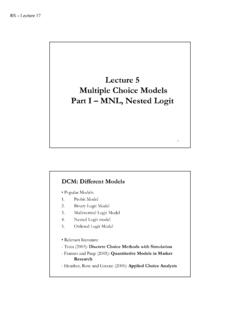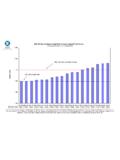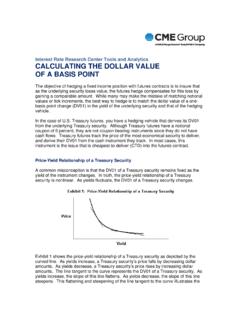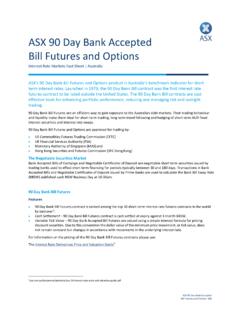Transcription of CHAPTER VI CURRENCY RISK MANAGEMENT: FUTURES …
1 CHAPTER VI CURRENCY RISK management : FUTURES AND FORWARDS In an international context, a very important area of risk management is CURRENCY risk. This risk represents the possibility that a domestic investor's holding of foreign CURRENCY will change in purchasing power when converted back to the home CURRENCY . CURRENCY risk also arises when a firm has assets or liabilities expressed in a foreign CURRENCY . Consider the following example. Example : Spec s, the Texas liquor store chain, regularly imports wine from Europe. Suppose Spec s has to pay for those imports EUR 5,000,000 on March 2.
2 Today, February 4, the exchange rate is USD/EUR. Situation: Payment due on March 2: EUR 5,000,000. SFeb 4 = USD/EUR. Problem: St is difficult to forecast Uncertainty Risk. Example: on January 2, St=Mar 2 > or < USD/EUR. At SFeb 4, Speck s total payment would be: EUR 5M x USD/EUR = USD On March 2 we have two potential scenarios with respect to today s valuation of EUR 5M: If the SMar 2 (USD appreciates) Spec s will pay less USD. If the SMar 2 (USD depreciates) Spec s will pay more USD.
3 The second scenario introduces CURRENCY Risk. We have seen that FX movements look like a random walk, then, CURRENCY risk is very difficult to avoid for transactions denominated in foreign CURRENCY . Then, CURRENCY risk becomes relevant when the value of an asset/liability change a lot when St moves. In finance, we relate a lot to the variance or volatility. For CURRENCY risk, we will look at the volatility of FX rates : More volatile currencies, higher CURRENCY risk. Example (continuation): Consider the following situations: (A) SMar 2 can be (i) USD/EUR, for a total payment: EUR 5M * USD/EUR = USD (ii) USD/EUR, for a total payment: EUR 5M * USD/EUR = USD (B) SMar 2 can be (i) USD/EUR, for a total payment: EUR 5M * USD/EUR = USD (ii) USD/EUR, for a total payment: EUR 5M * USD/EUR = USD Situation B is riskier (more volatile) for Spec s, since it may result in a higher payment.
4 How do we measure FX risk in FX markets? We use the distribution of st to understand and measure FX risk. Below, Table presents the distribution of st (with annualized mean & SD) from 1990:Jan - 2017:Dec, using monthly data. TABLE Distribution of Changes in Exchange rates for Selected Currencies (1990-2017) CURRENCY Mean Standard Deviation Skewness Excess Kurtosis Min Max Normal? GBP/USD No CHF/USD No EUR/USD No NOK/USD No INR/USD No JPY/USD No KRW/USD No THB/USD No SGD/USD No CNY/USD No SAR/USD No CAD/USD No MXN/USD No BRL/USD No ZAR/USD No EGP/USD No AUD/AUD No Average - - No Observations (typical of financial time series).
5 - On average, the USD appreciated against international currencies at an annualized mean of The average annualized SD is - Against developed currencies: annualized change (SD= ) - Excess Kurtosis. It describes the fatness of the tails. Under normality, excess kurtosis equals 0. All the currencies show excess kurtosis, that is, the tails are fatter than the tails of a normal , probability of a tail event is higher than what the normal distribution implies. - Skewness. If the distribution is symmetric (mean=median, for example, a normal), skewness is 0.
6 Almost all the currencies show positive skewness (mean>median); that is, the fat part of the curve is on the left. - st does not follow a normal distribution, as clearly seen in Graph Graph show the histogram and empirical distribution (in red) of changes in the GBP/USD. It is the typical behavior of a developed CURRENCY (against the USD). GRAPH Distribution of monthly changes in the GBP/USD exchange rate (1990-2017) FX volatility is a serious concern for many companies, especially during times of turbulence in FX markets, where extreme behavior can substantially swing the cash flows of firms (excess kurtosis helps to point out series with big swings).
7 The following example illustrates this point: the Thai cement giant, Siam City Cement, had big losses during the 1997 Asian Financial crisis, mainly due to liabilities denominated in foreign CURRENCY . Example : On July 2, 1997, Thailand devalued its CURRENCY , the baht (THB), by 18%. Siam City Cement, Thailand's second largest cement producer, lost THB 5,870 million (USD 146 million), giving a net deficit for the nine-month period of 1997 of THB 5,380 million. Siam City Cement reported a net profit of THB 817 million during the first nine months of 1996.
8 Industry analysts said that the company was affected by foreign exchange losses on USD 590 million foreign debt, reported as of June 30. These examples show that FX risk is a serious concern for companies and investors in international markets. Managing this risk is very important. CHAPTER I introduced the instruments of CURRENCY risk management . This CHAPTER studies the use of FUTURES and forward contracts to lessen the impact of CURRENCY risk on positions denominated in foreign currencies. The next CHAPTER studies CURRENCY options as a CURRENCY risk management tool.
9 I. FUTURES and Forward CURRENCY Contracts Before we start talking about FUTURES and forwards, we have to answer an important question: why do we care about FUTURES or forward contracts? In order to answer this question, we should recall that the primary goal of risk management is to change the risk-return profile of a cash position (or portfolio) to suit given investment objectives. This involves one of three alternatives: preserving value, limiting opportunity losses, or enhancing returns. FUTURES and forward contracts are effective in meeting these risk management objectives because they can be used as cost-efficient substitutes or proxies for a cash market position.
10 The determination of the proper equivalency ratio is critical to the use of FUTURES or forwards as a cash market proxy, regardless of whether this ratio will be applied to a hedge, an income enhancement strategy or a speculative position. The difference between FUTURES and forward contracts is the subject of Section I. The determination of the proper equivalency ratio is the subject of Section II. FUTURES and Forwards Contracts in Risk management This section presents the basic differences between FUTURES and forwards. They are instruments used for buying or selling a stated amount of foreign CURRENCY at a stated price per unit at a specified time in the future .

















